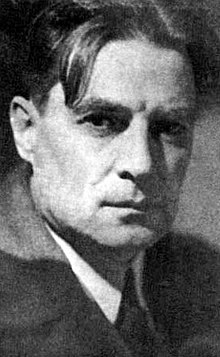Roberto Arlt
| Roberto Arlt | |
|---|---|
 |
|
| Born |
2 April 1900 Buenos Aires, Argentina |
| Died | 26 July 1942 (aged 42) Buenos Aires, Argentina |
| Resting place | Ashes scattered in Paraná River |
| Occupation | Novelist, dramatist and journalist |
| Language | Spanish |
| Nationality | Argentine |
| Subject | Argentine literature |
| Spouse | Carmen Antinucci (died in 1940); Elizabeth Shine |
| Children | Mirta Electra, Roberto |
Roberto Arlt (1900–1942) was an Argentine writer.
He was born Roberto Godofredo Christophersen Arlt in Buenos Aires on April 2, 1900. His parents were both immigrants: his father Karl Arlt was a Prussian from Posen (now Poznań in present-day Poland) and his mother was Ekatherine Iobstraibitzer, a native of Trieste and Italian speaking. German was the language commonly used at their home. His relationship with his father was stressful, as Karl Arlt was a very severe and austere man, by Arlt's own account. The memory of his oppressive father would appear in several of his writings. For example, Remo Erdosain (a character at least partially based on Arlt's own life) often recalls his abusive father and how little if any support he would give him. After being expelled from school at the age of eight, Arlt became an autodidact and worked at all sorts of different odd jobs before landing a job on at a local newspaper: as clerk at a bookstore, apprentice to a tinsmith, painter, mechanic, welder, manager in a brick factory, and dock worker.
His first novel, El juguete rabioso (1926) ("Mad Toy"), was the semi-autobiographical story of Silvio, a dropout who goes through a series of adventures trying to be "somebody." Narrated by Silvio's older self, the novel reflects the energy and chaos of the early 20th century in Buenos Aires. The narrator's literary and sometimes poetic language contrasts sharply with the street-level slang of Mad Toy's many colorful characters.
Arlt's second novel, the popular Los siete locos (The Seven Madmen) was rough, brutal, colloquial and surreal, a complete break from the polite, middle-class literature more typical of Argentine literature. Los lanzallamas (The Flame-Throwers) was the sequel, and these two novels together are thought by many to be his greatest work. What followed were a series of short stories and plays in which Arlt pursued his vision of bizarre, half-mad, alienated characters pursuing insane quests in a landscape of urban chaos. In 1932 he published El amor brujo.
During his lifetime, however, Arlt was best known for his "Aguafuertes" ("Etchings"), the result of his contributions as a columnist - between 1928 and 1942 - to the Buenos Aires daily "El Mundo". Arlt used these columns to comment, in his characteristically forthright and unpretentious style, on the peculiarities, hypocrisies, strangeness and beauty of everyday life in Argentina's capital. These articles included occasional exposés of public institutions, such as the juvenile justice system ("Escuela primaria de delincuencia", 26–29 September 1932) or the Public Health System. Some of the "Aguafuertes" were collected in two volumes under the titles Secretos femeninos. Aguafuertes inéditas and Tratado de delincuencia. Aguafuertes inéditas which were edited by Sergio Olguín and published by Ediciones 12 and Página/12 in 1996.
...
Wikipedia
